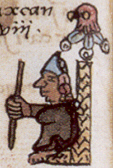
Our Lady of Guadalupe, also known as the Virgin of Guadalupe, is a Catholic title of Mary, mother of Jesus associated with a series of five Marian apparitions to a Mexican peasant named Juan Diego and his uncle, Juan Bernardino, which are believed to have occurred in December 1531, when the Mexican territories were under the Spanish Empire.
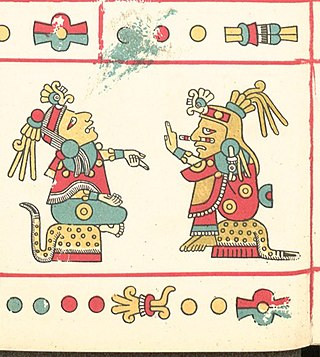
Ōmeteōtl is a name used to refer to the pair of Aztec deities Ometecuhtli and Omecihuatl, also known as Tōnacātēcuhtli and Tonacacihuatl. Ōme translates as "two" or "dual" in Nahuatl and teōtl translates as "god". The existence of such a concept and its significance is a matter of dispute among scholars of Mesoamerican religion. Ometeotl was one as the first divinity, and Ometecuhtli and Omecihuatl when the being became two to be able to reproduce all creation.

Tonantzin is a Nahuatl title composed of to- "our" + nān "mother" + -tzin "(honorific suffix)". When addressing Tonantzin directly, men use the suffixed vocative form Tonāntziné [], and women use the unsuffixed vocative form Tonāntzín [].
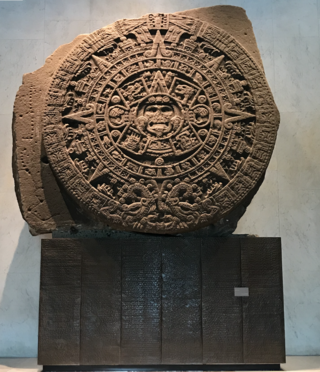
The Aztec or Mexica calendar is the calendrical system used by the Aztecs as well as other Pre-Columbian peoples of central Mexico. It is one of the Mesoamerican calendars, sharing the basic structure of calendars from throughout the region.

Luis Laso de la Vega was a 17th-century Mexican priest and lawyer. He is known chiefly as the author of the Huei tlamahuiçoltica, an account published in 1649 which contains a narrative describing the reported apparition of the Virgin Mary before Saint Juan Diego in 1531, some 117 years earlier. The account describes the appearance of the apparition now known as Our Lady of Guadalupe to Juan Diego at the hill of Tepeyac.The book was written in the Nahuatl language.
Juan Diego Bernardino was one of two Aztec peasants alleged to have had visions of the Virgin Mary as Our Lady of Guadalupe in 1531.

Huei Tlamahuiçoltica is a tract in Nahuatl comprising 36 pages and was published in Mexico City, Mexico in 1649 by Luis Laso de la Vega, the vicar of the chapel of Our Lady of Guadalupe at Tepeyac outside the same city. In the preface Luis Laso de la Vega claimed authorship of the whole work, but this claim is the subject of an ongoing difference of scholarly opinion.
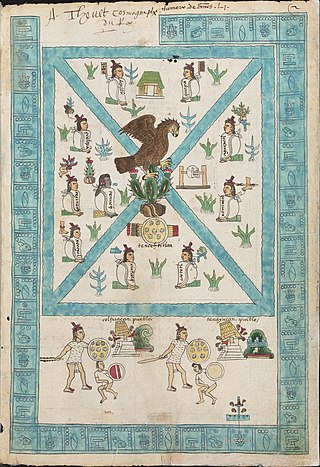
Aztec codices are Mesoamerican manuscripts made by the pre-Columbian Aztec, and their Nahuatl-speaking descendants during the colonial period in Mexico.
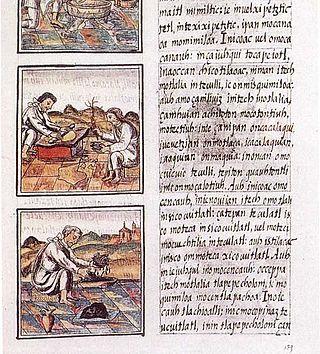
The Florentine Codex is a 16th-century ethnographic research study in Mesoamerica by the Spanish Franciscan friar Bernardino de Sahagún. Sahagún originally titled it La Historia General de las Cosas de Nueva España. After a translation mistake, it was given the name Historia general de las Cosas de Nueva España. The best-preserved manuscript is commonly referred to as the Florentine Codex, as the codex is held in the Laurentian Library of Florence, Italy.

Don Carlos de Sigüenza y Góngora was one of the first great intellectuals born in the New World - Spanish viceroyalty of New Spain. He was a criollo patriot, exalting New Spain over Old. A polymath and writer, he held many colonial government and academic positions. Sigüenza is considered the da Vinci mexicano.

Joaquín García Icazbalceta was a Mexican philologist and historian. He edited writings by Mexican writers who preceded him, wrote a biography of Juan de Zumárraga, and translated William H. Prescott's Conquest of Mexico. His works on Colonial Mexico continue to be cited today.
Miguel Sánchez (1594–1674) was a Novohispanic priest, writer and theologian. He is most renowned as the author of the 1648 publication Imagen de la Virgen María, a description and theological interpretation of an apparition to Juan Diego of the Virgin Mary as Our Lady of Guadalupe which is the first published narrative of the event. The precise nature of the cult before that date and whether the tradition as to the apparition dates back to 1531, constitute a vexed historical problem. The existence of a cult of the Virgin Mary at a chapel at Tepeyac, focussed on a painted cult image of the Virgin and enjoying a reputation for miraculous healing, was certainly established by 1556. Professor Brading, a scholar of Mexican history, noted of Sánchez: "even if he did not initiate the devotion, he determined the manner in which the image was exalted and justified."
Because Juan Diego did not speak Spanish, it has been proposed by multiple authors and analysts that the name Guadalupe, referring to the Virgin of Guadalupe, was likely derived from a word in the Nahuatl language.
Arthur James Outram Anderson was an American anthropologist specializing in Aztec culture and translator of the Nahuatl language.

Antonio Valeriano was a colonial Mexican, Nahua scholar and politician. He was a collaborator with fray Bernardino de Sahagún in the creation of the twelve-volume General History of the Things of New Spain, the Florentine Codex, He served as judge-governor of both his home, Azcapotzalco, and of Tenochtitlan, in Spanish colonial New Spain.
Informaciones Jurídicas de 1666 is a Spanish document that helped support the apparition of the Virgin Mary to Juan Diego Cuauhtlatoatzin at the hill of Tepeyac in 1531. The apparition is also known today as the iconic Virgin of Guadalupe. The Proceedings of 1666 consist of a series of investigations, record examinations, testimonies from artists, physicians, and Aztec historians, and oral accounts from elderly men and women who had knowledge and experience with Juan Diego and his contemporaries.

Juan Diego Cuauhtlatoatzin, also known simply as Juan Diego, was a Chichimec peasant and Marian visionary. He is said to have been granted apparitions of Our Lady of Guadalupe on four occasions in December 1531: three at the hill of Tepeyac and a fourth before don Juan de Zumárraga, then bishop of Mexico. The Basilica of Our Lady of Guadalupe, located at the foot of Tepeyac, houses the cloak (tilmahtli) that is traditionally said to be Juan Diego's, and upon which the image of the Virgin is said to have been miraculously impressed as proof of the authenticity of the apparitions.
The Mexica New Year is the celebration of the new year according to the Aztec calendar. The date on which the holiday falls in the Gregorian calendar depends on the version of the calendar used, but it is generally considered to occur at sunrise on 12 March. The holiday is observed in some Nahua communities in Mexico. To celebrate, ocote (pitch-pine) candles are lit on the eve of the new year, along with fireworks, drumming, and singing. Some of the most important events occur in Huauchinango, Naupan, Mexico City, Zongolica, and Xicotepec.
Marcos Cipac de Aquino (?–1572), informally known as Marcos the Indian, was a Roman Catholic Nahuatl artist in sixteenth-century Mexico, who may have been the painter of the image of the Virgin of Guadalupe.

